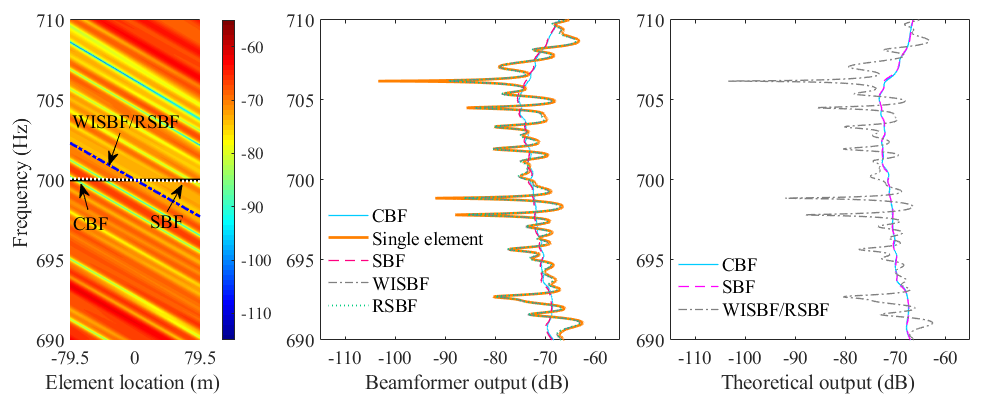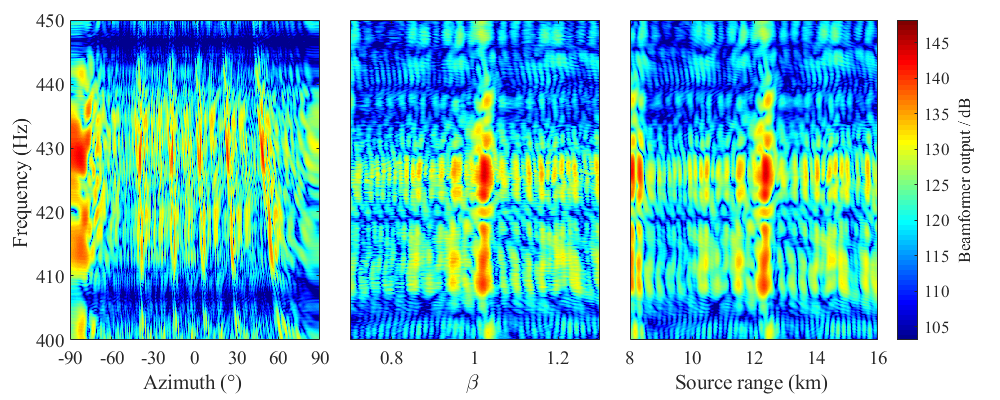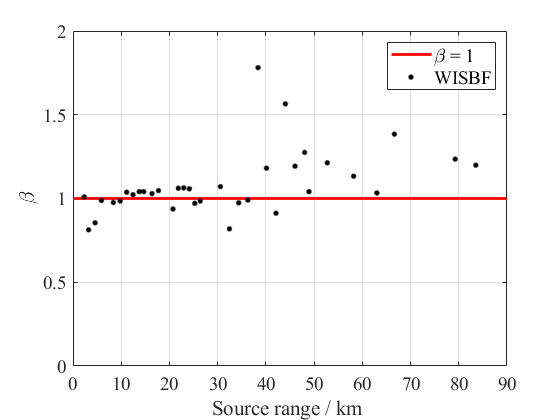There are regular interference striations due to the dispersion of normal modes in the shallow water. The waveguide invariant (WI) is considered as the most outstanding parameter to describe the interference structure. In the existing methods, the coupled formular with the ratio of WI and source range is widely used, where it is necessary to acquire one of the two parameters for estimating the other.
To address with this issue, previous researches proposed the striation-based beamforming (SBF) method, in which WI could be theoretically separated from source range through the azimuth difference between SBF and conventional beamforming (CBF). However, the azimuth scope for applying SBF with the best performance is limited, and its application requirements is not defined clear enough to make the technique practical.
In order to solve the problem, researchers from the Institute of Acoustics of the Chinese Academy of Sciences (IACAS) proposed waveguide-invariant-dimension striation-based beamformer (WISBF) and range-dimension striation-based beamformer (RSBF). These two modified methods could realize the separation of WI and source range without the azimuth limitation.
Researchers utilized the frequency-shift compensation theory to establish the phase and amplitude relationship in element-frequency domain for the horizontal line array (HLA) of shallow water. The separated structure of WI and source range existed in the phase relationship, which were then used to generate striation-based beamforming weights that matching search in WI or source range dimension.
Compared with matching azimuth in the SBF, WISBF and RSBF could output the location of the main lobe that was independent of source azimuth so as to eliminate the azimuth limitation. Especially for the conditions of source near array end-fire, receiving array of large-aperture and received signals in high frequency, WISBF and RSBF were equipped with the ability to process array signals in the best correlation.
Based on the phase relationship in the element-frequency domain, researchers found the source whose spectrum varies slowly and received signals that contained the complete information of transmission time were keys for applying SBF to real work.
The proposed methods and relative conclusions were discussed with the data from experiment conducted in the 2011 winter of the north Yellow Sea with several explosive charges. The sound speed of the experimental field was nearly constant with the mean value 1480m/s, one HLA with aperture about 250 m was deployed on the seabed (73±3 m), and the studied signals exploded at the depth 25 m of the end-fire location. The results showed that WISBF and RSBF were successfully applied to the sources and produced effective beamformer output and estimations.
The research, published online in the Journal of Theoretical and Computational Acoustics (JTCA), was supported by the National Natural Science Foundation of China (Nos. 11804362 and 11804364).

Figure 1. Simulation results, beamforming difference of a case in Pekeris waveguide with depth of 105 m and sound speed of 1500 m/s. One HLA with aperture of 159 m is deployed at depth of 60 m, and the aource is at depth of 4 m and azimuth of 65°, noise is not taken into consideration. Compared with CBF and SBF, it is shown WISBF/RSBF could acquire higher processing gain and nearly distortion-free interference structure.(Image by IACAS)

Figure 2. Experimental data results with one explosive source at the range of 12.45 km. Each sub-figure is corresponding to CBF, WISBF and RSBF, β represents the waveguide invariant. (Image by IACAS)

Figure 3. The waveguide invariant estimations of the whole 35 explosive sources. (Image by IACAS)
Reference:
LIU Chang Peng, ZHOU Shi Hong, HUI Juan, REN Yun, QI Yu Bo. Performance Metrics for Striation-based Beamforming and Application Requirements with the Horizontal Line Array in Shallow Water, Journal of Theoretical and Computational Acoustics, doi: 10.1142/S2591728520500280
Contact:
ZHOU Wenjia
Institute of Acoustics, Chinese Academy of Sciences, 100190 Beijing, China
E-mail: media@mail.ioa.ac.cn


